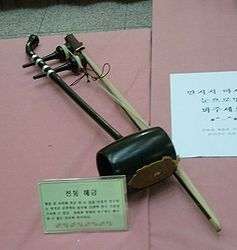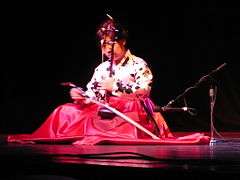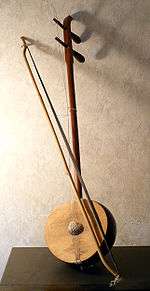Haegeum
 | |
| Classification | Bowed string instrument |
|---|---|
| Related instruments | |
| Erhu, Erxian | |
| Korean name | |
| Hangul | 해금 |
|---|---|
| Hanja | 奚琴 |
| Revised Romanization | haegeum |
| McCune–Reischauer | haegŭm |
The haegeum (Hangul: 해금) is a traditional Korean string instrument, resembling a fiddle. It is popularly known as kkangkkangi.[1] It has a rodlike neck, a hollow wooden soundbox, and two silk strings, and is held vertically on the knee of the performer and played with a bow.
The haegeum is one of the most widely used instruments in Korean music. The haegeum is used in court music as well as madangnori (ordinary people's music). The haegeum's range of expression is various despite having only two strings, with sounds ranging from sorrowful and sad to humorous. The haegeum is made using eight materials: gold, rock, thread, bamboo, gourd, soil, leather, and wood, and so it is called paleum (eight sounds).

The sohaegeum (소해금) is a modernized fiddle with four strings, used only in North Korea and in the Yanbian Korean Autonomous Prefecture in China.photo
History
There are no records about the exact era when the haegeum was first introduced in Korea. According to several sources, references to the haegeum can be found in hanlimbyeolgok (the unrhymed verse and songs of the royal scholars) made in the Goryeo dynasty, so it can be inferred that the haegeum has been played at least since then.
In the Joseon Dynasty, the haegeum was used in various music: that of royal ancestral rites, parades, festivals, and hyangak (Korean music).
The way the haegeum is played changed dramatically since the Joseon Dynasty. In the past, musicians plucked the string as it was tuned, but since that time they have begun pulling the string while they play it to express sound in many ways.
To improve the acoustic ability of the haegeum, various modifications have been introduced since the 1960s. In 1965, Park Hun-bong and Kim Bun-gi developed a low-tune Haegeum, and in 1967 Kim Gisu made a small haegeum.[2]
